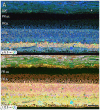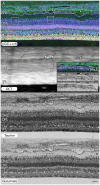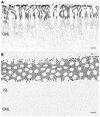Retinal Remodeling and Metabolic Alterations in Human AMD
- PMID: 27199657
- PMCID: PMC4848316
- DOI: 10.3389/fncel.2016.00103
Retinal Remodeling and Metabolic Alterations in Human AMD
Abstract
Age-related macular degeneration (AMD) is a progressive retinal degeneration resulting in central visual field loss, ultimately causing debilitating blindness. AMD affects 18% of Americans from 65 to 74, 30% older than 74 years of age and is the leading cause of severe vision loss and blindness in Western populations. While many genetic and environmental risk factors are known for AMD, we currently know less about the mechanisms mediating disease progression. The pathways and mechanisms through which genetic and non-genetic risk factors modulate development of AMD pathogenesis remain largely unexplored. Moreover, current treatment for AMD is palliative and limited to wet/exudative forms. Retina is a complex, heterocellular tissue and most retinal cell classes are impacted or altered in AMD. Defining disease and stage-specific cytoarchitectural and metabolic responses in AMD is critical for highlighting targets for intervention. The goal of this article is to illustrate cell types impacted in AMD and demonstrate the implications of those changes, likely beginning in the retinal pigment epithelium (RPE), for remodeling of the the neural retina. Tracking heterocellular responses in disease progression is best achieved with computational molecular phenotyping (CMP), a tool that enables acquisition of a small molecule fingerprint for every cell in the retina. CMP uncovered critical cellular and molecular pathologies (remodeling and reprogramming) in progressive retinal degenerations such as retinitis pigmentosa (RP). We now applied these approaches to normal human and AMD tissues mapping progression of cellular and molecular changes in AMD retinas, including late-stage forms of the disease.
Keywords: Müller cell; age-related macular degeneration (AMD); computational molecular phenotyping (CMP); neural remodeling; photoreceptor; retina; retinal pigment epithelium (RPE); retinal remodeling.
Figures










Similar articles
-
Extreme retinal remodeling triggered by light damage: implications for age related macular degeneration.Mol Vis. 2008 Apr 25;14:782-806. Mol Vis. 2008. PMID: 18483561 Free PMC article.
-
Retinal remodeling in human retinitis pigmentosa.Exp Eye Res. 2016 Sep;150:149-65. doi: 10.1016/j.exer.2016.03.018. Epub 2016 Mar 26. Exp Eye Res. 2016. PMID: 27020758 Free PMC article. Review.
-
Retinal Degeneration, Remodeling and Plasticity.2016 Oct 28. In: Kolb H, Fernandez E, Jones B, Nelson R, editors. Webvision: The Organization of the Retina and Visual System [Internet]. Salt Lake City (UT): University of Utah Health Sciences Center; 1995–. 2016 Oct 28. In: Kolb H, Fernandez E, Jones B, Nelson R, editors. Webvision: The Organization of the Retina and Visual System [Internet]. Salt Lake City (UT): University of Utah Health Sciences Center; 1995–. PMID: 29493934 Free Books & Documents. Review.
-
Stem cell based therapies for age-related macular degeneration: The promises and the challenges.Prog Retin Eye Res. 2015 Sep;48:1-39. doi: 10.1016/j.preteyeres.2015.06.004. Epub 2015 Jun 23. Prog Retin Eye Res. 2015. PMID: 26113213 Review.
-
RPE phagocytic function declines in age-related macular degeneration and is rescued by human umbilical tissue derived cells.J Transl Med. 2018 Mar 13;16(1):63. doi: 10.1186/s12967-018-1434-6. J Transl Med. 2018. PMID: 29534722 Free PMC article.
Cited by
-
Cones in ageing and harsh environments: the neural economy hypothesis.Ophthalmic Physiol Opt. 2020 Mar;40(2):88-116. doi: 10.1111/opo.12670. Epub 2020 Feb 4. Ophthalmic Physiol Opt. 2020. PMID: 32017191 Free PMC article. Review.
-
Retinal Aging Transcriptome and Cellular Landscape in Association With the Progression of Age-Related Macular Degeneration.Invest Ophthalmol Vis Sci. 2023 Apr 3;64(4):32. doi: 10.1167/iovs.64.4.32. Invest Ophthalmol Vis Sci. 2023. PMID: 37099020 Free PMC article.
-
Ocular indicators of Alzheimer's: exploring disease in the retina.Acta Neuropathol. 2016 Dec;132(6):767-787. doi: 10.1007/s00401-016-1613-6. Epub 2016 Sep 19. Acta Neuropathol. 2016. PMID: 27645291 Free PMC article. Review.
-
Advances in the development of new biomarkers for Alzheimer's disease.Transl Neurodegener. 2022 Apr 21;11(1):25. doi: 10.1186/s40035-022-00296-z. Transl Neurodegener. 2022. PMID: 35449079 Free PMC article. Review.
-
A Microfluidic Eye Facsimile System to Examine the Migration of Stem-like Cells.Micromachines (Basel). 2022 Mar 2;13(3):406. doi: 10.3390/mi13030406. Micromachines (Basel). 2022. PMID: 35334698 Free PMC article.
References
Grants and funding
LinkOut - more resources
Full Text Sources
Other Literature Sources

